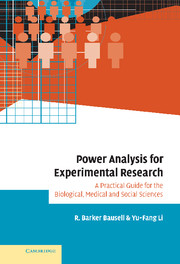 Power Analysis for Experimental Research
Power Analysis for Experimental Research Book contents
- Frontmatter
- Contents
- Introduction
- 1 The conceptual underpinnings of statistical power
- 2 Strategies for increasing statistical power
- 3 General guidelines for conducting a power analysis
- 4 The t-test for independent samples
- 5 The paired t-test
- 6 One-way between subjects analysis of variance
- 7 One-way between subjects analysis of covariance
- 8 One-way repeated measures analysis of variance
- 9 Interaction effects for factorial analysis of variance
- 10 Power analysis for more complex designs
- 11 Other power analytic issues and resources for addressing them
- Technical appendix
- Bibliography
- Index
8 - One-way repeated measures analysis of variance
Published online by Cambridge University Press: 28 August 2009
- Frontmatter
- Contents
- Introduction
- 1 The conceptual underpinnings of statistical power
- 2 Strategies for increasing statistical power
- 3 General guidelines for conducting a power analysis
- 4 The t-test for independent samples
- 5 The paired t-test
- 6 One-way between subjects analysis of variance
- 7 One-way between subjects analysis of covariance
- 8 One-way repeated measures analysis of variance
- 9 Interaction effects for factorial analysis of variance
- 10 Power analysis for more complex designs
- 11 Other power analytic issues and resources for addressing them
- Technical appendix
- Bibliography
- Index
Summary
Purpose of the statistic
The one-way, repeated measures analysis of variance is exactly analogous to the one-way between subjects ANOVA except that the groups contain either the same subjects or individuals who have been explicitly matched in some way. It is used to ascertain how likely these within subject mean differences would be to occur by chance alone. Studies that might employ such a design include the multiple (i.e., three or more times) measurement of a single group of individuals across time (e.g., adding a long term follow-up assessment to a single group, pretest-posttest design) or, less commonly, a situation in which the same group of individuals is exposed to three or more different conditions.
A within subject design is extremely efficient in comparison to one which employs different subjects in each group, requiring far fewer subjects when even a moderate correlation can be obtained among its repeated observations. A one-way, repeated measures (RM) ANOVA, then, is used when:
there is a single, independent variable which is defined as group membership in three or more groups or as three or more separate points in time (recalling that if only two groups are involved a paired t-test can be employed, which is inferentially identical to a two-group RM ANOVA),
the dependent variable is measured in such a way that it can be described by a mean (i.e., it is continuous in nature and not categorical),
[…]
- Type
- Chapter
- Information
- Power Analysis for Experimental ResearchA Practical Guide for the Biological, Medical and Social Sciences, pp. 179 - 238Publisher: Cambridge University PressPrint publication year: 2002
- 2
- Cited by


